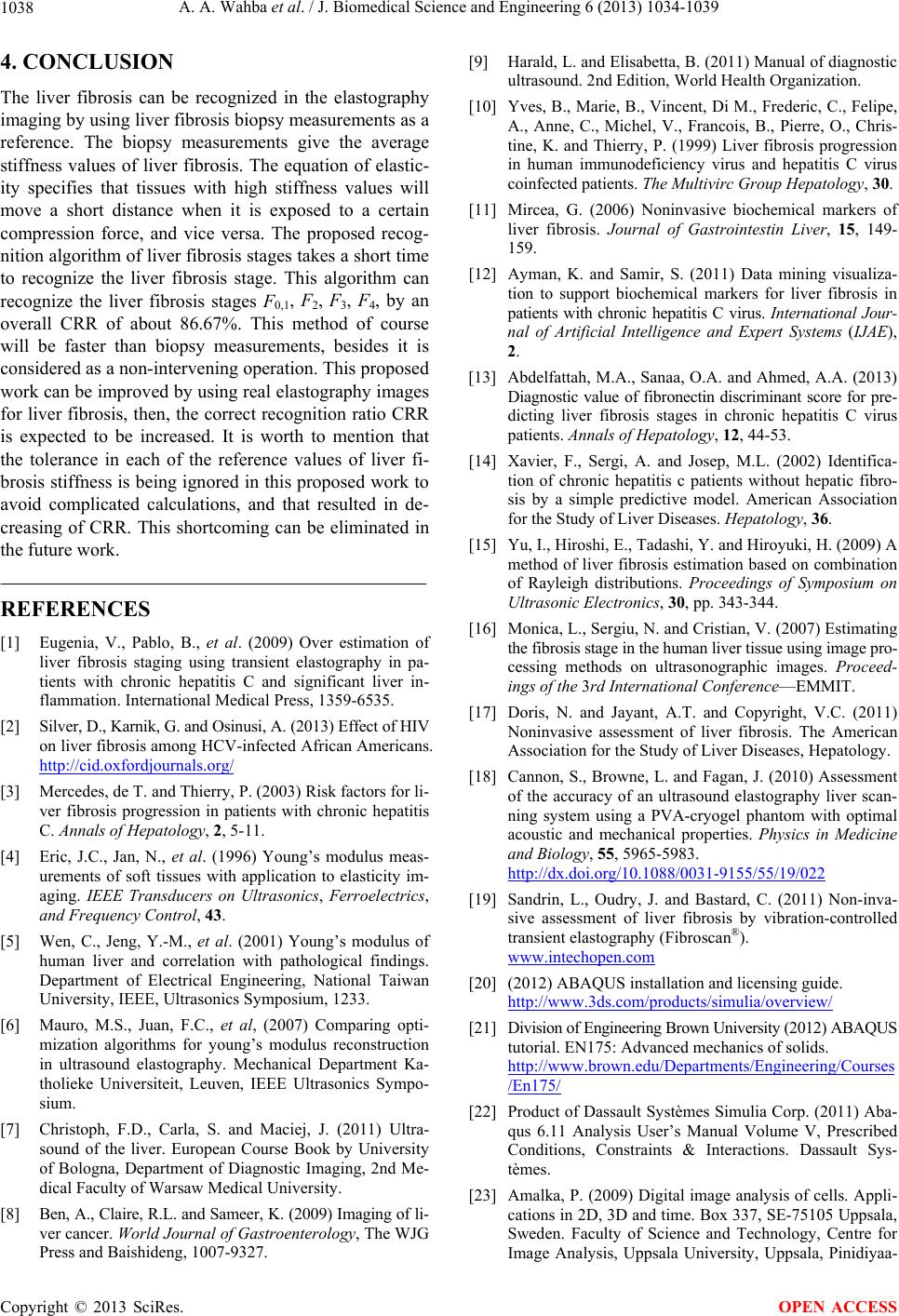
A. A. Wahba et al. / J. Biomedical Science and Engineering 6 (2013) 1034-1039
1038
4. CONCLUSION
The liver fibrosis can be recognized in the elastography
imaging by using liver fibrosis biopsy measurements as a
reference. The biopsy measurements give the average
stiffness values of liver fibrosis. The equation of elastic-
ity specifies that tissues with high stiffness values will
move a short distance when it is exposed to a certain
compression force, and vice versa. The proposed recog-
nition algorithm of liver fibrosis stages takes a short time
to recognize the liver fibrosis stage. This algorithm can
recognize the liver fibrosis stages F0,1, F2, F3, F4, by an
overall CRR of about 86.67%. This method of course
will be faster than biopsy measurements, besides it is
considered as a non-intervening operation. This proposed
work can be improved by using real elastography images
for liver fibrosis, then, the correct recognition ratio CRR
is expected to be increased. It is worth to mention that
the tolerance in each of the reference values of liver fi-
brosis stiffness is being ignored in this proposed work to
avoid complicated calculations, and that resulted in de-
creasing of CRR. This shortcoming can be eliminated in
the future work.
REFERENCES
[1] Eugenia, V., Pablo, B., et al. (2009) Over estimation of
liver fibrosis staging using transient elastography in pa-
tients with chronic hepatitis C and significant liver in-
flammation. International Medical Press, 1359-6535.
[2] Silver, D., Karnik, G. and Osinusi, A. (2013) Effect of HIV
on liver fibrosis among HCV-infected African Americans.
http://cid.oxfordjournals.org/
[3] Mercedes, de T. and Thierry, P. (2003) Risk factors for li-
ver fibrosis progression in patients with chronic hepatitis
C. Annals of Hepatology, 2, 5-11.
[4] Eric, J.C., Jan, N., et al. (1996) Young’s modulus meas-
urements of soft tissues with application to elasticity im-
aging. IEEE Transducers on Ultrasonics, Ferroelectrics,
and Frequency Control, 43.
[5] Wen, C., Jeng, Y.-M., et al. (2001) Young’s modulus of
human liver and correlation with pathological findings.
Department of Electrical Engineering, National Taiwan
University, IEEE, Ultrasonics Symposium, 1233.
[6] Mauro, M.S., Juan, F.C., et al, (2007) Comparing opti-
mization algorithms for young’s modulus reconstruction
in ultrasound elastography. Mechanical Department Ka-
tholieke Universiteit, Leuven, IEEE Ultrasonics Sympo-
sium.
[7] Christoph, F.D., Carla, S. and Maciej, J. (2011) Ultra-
sound of the liver. European Course Book by University
of Bologna, Department of Diagnostic Imaging, 2nd Me-
dical Faculty of Warsaw Medical University.
[8] Ben, A., Claire, R.L. and Sameer, K. (2009) Imaging of li-
ver cancer. World Journal of Gastroenterology, The WJG
Press and Baishideng, 1007-9327.
[9] Harald, L. and Elisabetta, B. (2011) Manual of diagnostic
ultrasound. 2nd Edition, World Health Organization.
[10] Yves, B., Marie, B., Vincent, Di M., Frederic, C., Felipe,
A., Anne, C., Michel, V., Francois, B., Pierre, O., Chris-
tine, K. and Thierry, P. (1999) Liver fibrosis progression
in human immunodeficiency virus and hepatitis C virus
coinfected patients. The Multivirc Group Hepatology, 30.
[11] Mircea, G. (2006) Noninvasive biochemical markers of
liver fibrosis. Journal of Gastrointestin Liver, 15, 149-
159.
[12] Ayman, K. and Samir, S. (2011) Data mining visualiza-
tion to support biochemical markers for liver fibrosis in
patients with chronic hepatitis C virus. International Jour-
nal of Artificial Intelligence and Expert Systems (IJAE),
2.
[13] Abdelfattah, M.A., Sanaa, O.A. and Ahmed, A.A. (2013)
Diagnostic value of fibronectin discriminant score for pre-
dicting liver fibrosis stages in chronic hepatitis C virus
patients. Annals of Hepatology, 12, 44-53.
[14] Xavier, F., Sergi, A. and Josep, M.L. (2002) Identifica-
tion of chronic hepatitis c patients without hepatic fibro-
sis by a simple predictive model. American Association
for the Study of Liver Diseases. Hepatology, 36.
[15] Yu, I., Hiroshi, E., Tadashi, Y. and Hiroyuki, H. (2009) A
method of liver fibrosis estimation based on combination
of Rayleigh distributions. Proceedings of Symposium on
Ultrasonic Electronics, 30, pp. 343-344.
[16] Monica, L., Sergiu, N. and Cristian, V. (2007) Estimating
the fibrosis stage in the human liver tissue using image pro-
cessing methods on ultrasonographic images. Proceed-
ings of the 3rd International Conference—EMMIT.
[17] Doris, N. and Jayant, A.T. and Copyright, V.C. (2011)
Noninvasive assessment of liver fibrosis. The American
Association for the Study of Liver Diseases, Hepatology.
[18] Cannon, S., Browne, L. and Fagan, J. (2010) Assessment
of the accuracy of an ultrasound elastography liver scan-
ning system using a PVA-cryogel phantom with optimal
acoustic and mechanical properties. Physics in Medicine
and Biology, 55, 5965-5983.
http://dx.doi.org/10.1088/0031-9155/55/19/022
[19] Sandrin, L., Oudry, J. and Bastard, C. (2011) Non-inva-
sive assessment of liver fibrosis by vibration-controlled
transient elastography (Fibroscan®).
www.intechopen.com
[20] (2012) ABAQUS installation and licensing guide.
http://www.3ds.com/products/simulia/overview/
[21] Division of Engineering Brown University (2012) ABAQUS
tutorial. EN175: Advanced mechanics of solids.
http://www.brown.edu/Departments/Engineering/Courses
/En175/
[22] Product of Dassault Systèmes Simulia Corp. (2011) Aba-
qus 6.11 Analysis User’s Manual Volume V, Prescribed
Conditions, Constraints & Interactions. Dassault Sys-
tèmes.
[23] Amalka, P. (2009) Digital image analysis of cells. Appli-
cations in 2D, 3D and time. Box 337, SE-75105 Uppsala,
Sweden. Faculty of Science and Technology, Centre for
Image Analysis, Uppsala University, Uppsala, Pinidiyaa-
Copyright © 2013 SciRes. OPEN ACCESS